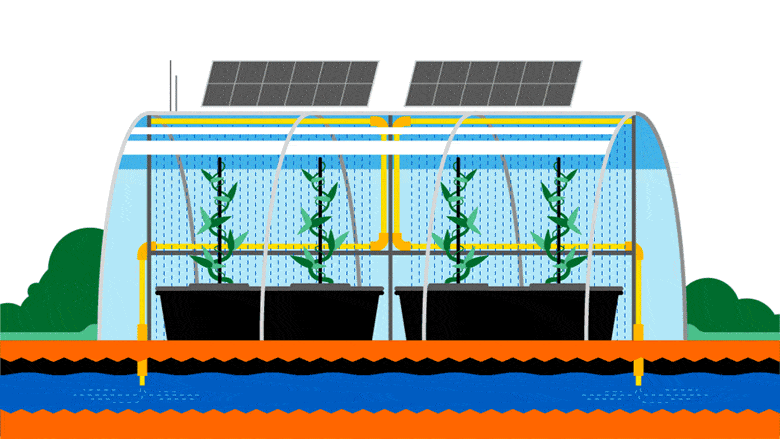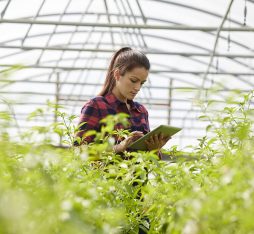• The high-precision supervision, monitoring and irrigation of greenhouse crops can optimize production and product quality while saving water.
• For emerging markets and countries affected by climatic instability, these high-technology solutions can provide predictable yields that help to stabilise food prices.
To grow 1,000 tons of cucumbers and tomatoes in Siberia: that is the challenge won by a Japanese company thanks to its connected greenhouses.
Breaking new ground with a domestic solution for the remote monitoring and automated cultivation of crops, the government of Costa Rica with support from South Korea and the Central American Bank for Economic Integration (CABEI) has launched a new greenhouse project with sensors that measure light, heat, movement, humidity and pressure and remotely controlled control cooling, heating, lighting, and irrigation systems. The large-scale facility which consists of two greenhouses for tomatoes and sweet peppers, a control room, a nursery, and a storage space for agricultural inputs, is just one of many that are now being built around the world, which has to meet the challenge of producing more food. In order to feed a projected global population of nine billion people by 2050, the FAO (Food and Agriculture Organisation of the United Nations) estimates that food production will need to be increased by 60%. The hope is that advanced technology for the optimization of agricultural yields and smart greenhouses in particular will contribute to achieving this goal. At the same time, the new production facilities are particularly popular in developing countries like Cameroon, which are eager to stabilise volatile food prices.
The integration of smart irrigation can help greenhouse growers achieve 30% water and fertilizer efficiency, and 20% quality and production increases
A wealth of IoT devices and sensors
Sensors play an essential role in smart greenhouses, notably with regard to reducing water consumption. According to a recent report in Greenhouse Management magazine, “recirculating water and integrating smart irrigation practices can help greenhouse growers achieve 30% water and fertilizer efficiency, 20% quality and production increases, and 10% labour efficiency.” Not surprisingly, agriculture is now the second largest market for IoT just behind industry. The market sector, which was worth 12.3 billion dollars in 2023, is expected to reach 31 billion dollars by 2030. The demand for sensors is being driven by precision agriculture and growers wishing to monitor crops in real time.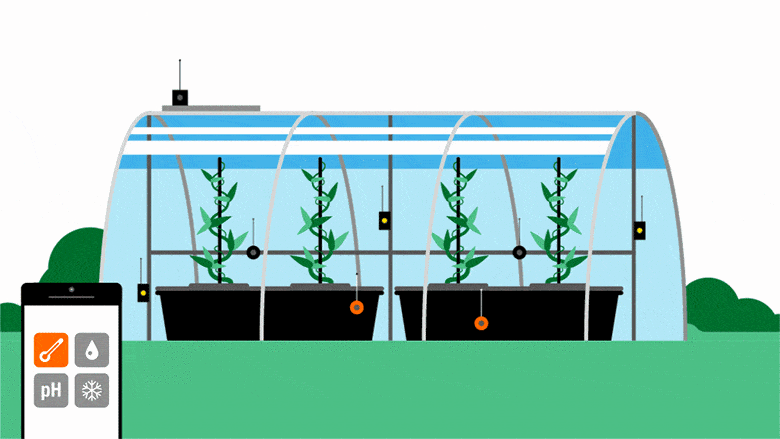
Deployment of the new devices has been made easier by the development of wireless communications that connect to low-speed M2M (machine-to-machine) networks with protocols that are simpler, more energy efficient, and cheaper than Bluetooth, such as LoRa, an open source technology based on long range radio waves notably used by Orange, and LTE-M, an extension of the 4G standard. When combined with smartphone or computer applications, the sensors can provide invaluable strategic guidance for farmers. In the near future, they may even be battery-free and powered by energy sourced from soil, like the novel devices produced by British start-up Bactery.
Overcoming climate limitations
In Siberia, Japanese company JGC Evergreen is growing 1,000 tons of cucumbers and tomatoes a year in what has been billed as the world’s first perma-frost greenhouse farm. In the Inuvik region of Canada, 100 kilometres from the Arctic ocean, hi-tech greenhouses also represent a real hope to improve the food self-sufficiency of an entire community. In this cold and remote region where imported agricultural produce is very expensive, Canadian company Modular Farms, a builder of customized container farms that can withstand harsh winter weather extremes, is developing modules made up of 240 vertical towers that can support the growth of 3,800 plants under LED lights. The technique used is hydroponics, a cultivation method that grows plants on a substrate irrigated with a solution rich in mineral salts and essential nutrients. A HVAC system maintains the temperature, and the steel walls of the greenhouse are so well insulated that the excess heat produced by the LEDs and the dehumidifier is often sufficient to keep it warm. A wireless monitoring system gathers data on a wide range of parameters, from air humidity to the composition of solutions used to immerse plants’ roots, and these are monitored remotely by the company from its offices in Toronto which contacts local staff in the event of problems.
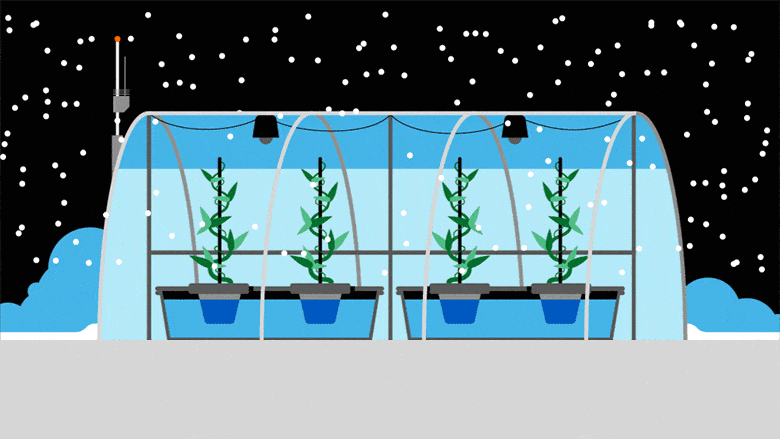 For these biometry pioneers, the challenge now is to increase the number of parameters monitored by greenhouse sensors and to increase plants’ nutritional quality. At McGill University in Montreal, bioresource engineers are studying the optimum length of light waves to boost growth, and in particular red light which is known to accelerate photosynthesis. One of the goals of this research is to enable Arctic greenhouses to produce more food without expending more energy on lighting. Innovation is also continuing with the development of plants which have inbuilt plant biomarkers that produce a fluorescent protein when they are exposed to stress from low temperatures.
For these biometry pioneers, the challenge now is to increase the number of parameters monitored by greenhouse sensors and to increase plants’ nutritional quality. At McGill University in Montreal, bioresource engineers are studying the optimum length of light waves to boost growth, and in particular red light which is known to accelerate photosynthesis. One of the goals of this research is to enable Arctic greenhouses to produce more food without expending more energy on lighting. Innovation is also continuing with the development of plants which have inbuilt plant biomarkers that produce a fluorescent protein when they are exposed to stress from low temperatures.
Food self-sufficiency for all?
Not only can smart greenhouses feed populations in regions with extreme climates, they can also provide food self-sufficiency for French families. Greenhouses developed by the start-up myfood, which has received support from Orange, combine permaculture and aquaponics by growing plants with their roots immersed in tanks, which are home to fish whose waste is used to provide a source of crop nutrients. Sensors are everywhere in these greenhouses, which generate their own energy using solar panels: millions of measurements including data on air temperature and water pH are sent to a server via Orange’s LoRa network, where they are analysed by artificial intelligence and returned to a local application that centralizes a full range of control and follow-up parameters, notably adjusting levels of greenhouse ventilation and updating the plantation maintenance schedule.
According to myfood and Orange, a combined permaculture and aquaponics greenhouse, which retails for € 8,000 including delivery and installation, can produce up to 400kg of organic nutrient-rich vegetables and 50kg of fish per year.
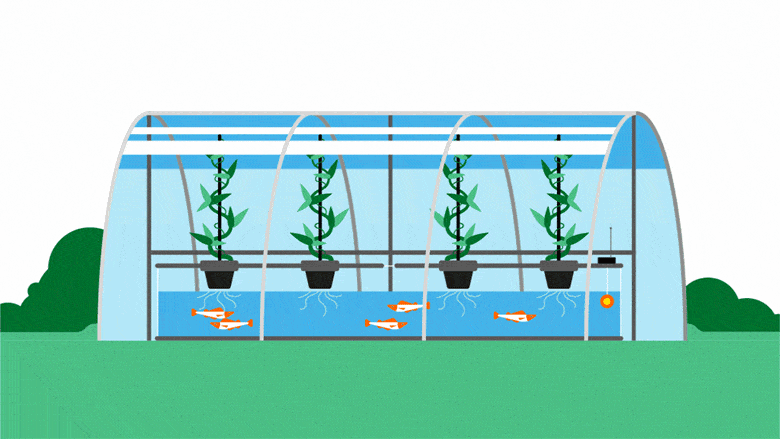
Living buildings integrated in natural systems :
Smart greenhouses offer a vision of the future in which human beings have overcome the limitations of climate and natural resources to take charge of their own food needs. However, development in Agtech is not necessarily limited to soilless horticulture disconnected from nature: the technology also features in sustainable biomimetic living spaces which are integrated with natural systems. One example of such a project is the Omega Centre for Sustainable Living (OCSL) in the United States. The net zero-energy, solar-powered building is equipped with a closed-loop reclamation system for water which is pumped from the ground, used for the occupants’ toilets, sinks, and showers, then sent to serve in a greenhouse where it is filtered by algae, bacteria, and fungi, before being redeployed to water a vegetable garden or returned to the local aquifer. The building not only feeds its occupants but treats all of its wastewater with a system powered only by gravity and solar energy, which does not require any chemical inputs. With these improvements to its environmental footprint, the OSCL is no longer a manmade encumbrance, but a living building that is integrated in natural systems.
